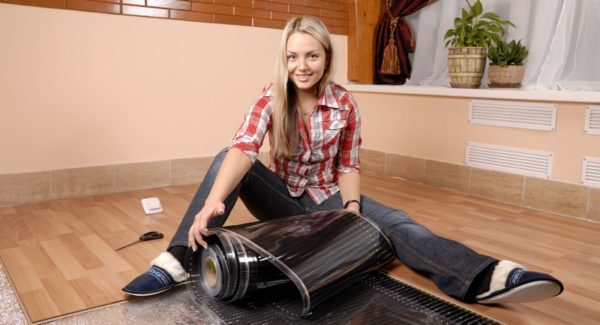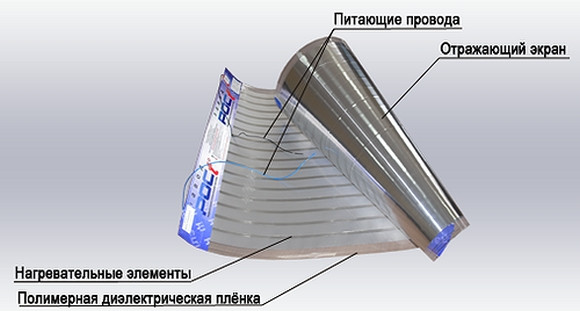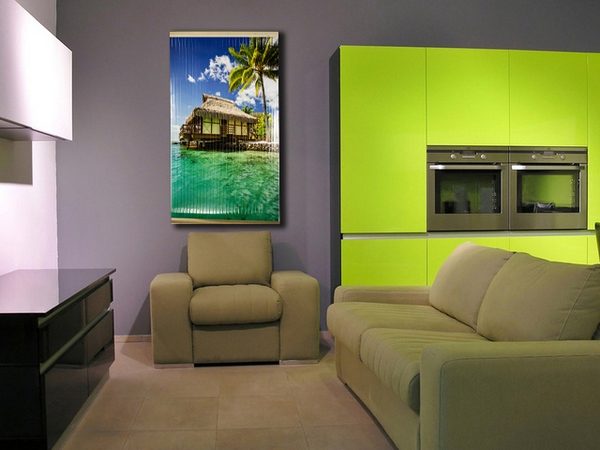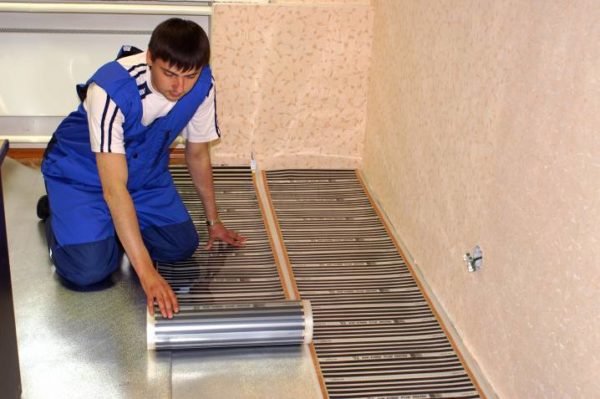New heat source: infrared film heater
In cold weather, each of us is looking for an efficient way to heat our home without the enormous financial costs and intimidating utility bills. In the category of price = quality film films are actively gaining popularity. infrared heaters.
Content
Main characteristics
Such an infrared heater has the appearance of a web covered on both sides with a plastic film. Thanks to a layer of carbon fiber and a pair of copper tires, it has 100% heat transfer. Carbon heater can act both as the main, and additional source of heat. The film is installed under the wall, ceiling and floor decoration. It is used in the insulation of schools, industrial premises, garages, bathhouses, private houses, sports grounds.
The film-type heater weighs from 300 to 500 g, its length is 30-120 cm.
It works due to radiation of a long-wavelength infrared ray.

Principle of construction
An infrared heater contains a large number of fibers located on a heat-resistant film. The design has excellent flexibility. It is divided into types, depending on the place of installation - the floor, walls, ceiling.
Carbon fiber film heater consists of 3 parts:
- The heating part that converts electrical energy into heat.
- Foil, whose task - evenly distribute heat over the entire surface.
- And directly the film itself, which serves as protection from external factors.

Many infrared heaters are made in the form of pictures or paintings, which allows them to blend harmoniously into the interior.
Thus, not just an infrared film heater can hang on the wall, but a beautiful picture that gives warmth.

Scheme of work
All infrared devices are made according to the principle of the sun. The sun's rays, reaching the ground, warm water, trees, buildings, similarly - infrared radiation heats the surrounding objects, the heat from which is then transmitted to the air (for more details on how they work, see the articleprinciple of operation of the heater with infrared radiation).
Heat generation occurs immediately after the supply of current. After passing through the components of heating, the current is converted into thermal energy, which radiates infrared waves through the film.
If the film is under the floor, then first of all the wave acts on the floor, and then on the rest of the space.
 Benefits
Benefits
The increasing popularity of this heater is not accidental, because it has a number of advantages:
- Wellness effect. Film heaters emit infrared radiation, which have a beneficial effect on humans. The rays activate the circulatory system and replace the lack of sun in winter.
- Does not dry the air. Infrared heaters do not disturb the natural oxygen balance, making the air in the room even slightly moistened.
- Easy installation. Installed design is extremely simple. After reviewing the instructions, everyone can complete the installation.
- Security. In studies of the device, no harm to human and animal health was found. In confirmation of this, sanitary and epidemiological documents are issued for products.
- Long term work.On average, film heaters, if properly installed and properly used, will last about forty years. Even if individual elements are damaged, the system does not stop working. Leaving is also not required, the principle of "bought and forgotten" applies.
- Saving. Primary costs for the purchase and installation of substantially lower installation of gas or electrical equipment. But the main thing is that during the use of the device, compared with the usual heating systems, the costs are significantly lower.
- Minimum noise level. Infrared heater works almost silently - without the characteristic buzz inherent in other heaters.
- Not afraid of moisture. Heating installation is suitable for damp and damp rooms.
- It is possible to adjust the temperature and automatic heating function. In each room you can set a different temperature. There is a fast heating mode.
disadvantages
Despite the weighty list of positive characteristics, the film heater still has limitations in use:
- Under the laminate floor, floorboard and carpet, you can not install a film with a heating above 27 0C. For tile and expanded clay required from 45 0WITH.
- For heating spacious rooms need higher power, which may be unavailable.
- High ceilings prevent the full use of radiation.
- As the main source of heating is suitable only in mild climates. In the harsh winter, film heaters are better left to the role of an additional source of heat. Alternatively, you can warm separate small rooms, such as a loggia.
- Necessary masking of the heater under the finishing materials. Eyes may be tired from reflections of the device.
- High requirements for thermal insulation of the room.
- Film sheets must not be painted, plastered or wallpaper-bonded.
Installation of film heater
Despite the ease of installation of the carbon film, some rules should not be ignored:
- The material is laid on a dry and flat surface.
- Cut must be strictly on the specified lines.
- Do not connect electricity while the device is rolled.
- The length of the film is allowed, not exceeding 8 m, and the gap between the canvases should be not less than 5 mm.
- The film must not be bent more than 90 degrees.
- Fastening to do only the construction stapler or fasteners. Do not use nails or screws.
- It is recommended to carry out installation in cold weather.
The first step is to install reflective foil on the prepared area. The bands are fixed with foil tape. After that, the heating elements are installed and the wires are insulated. If you wish, you can connect the thermostat. It is necessary to work in automatic mode.

Before installing the film, you must read the instructions, because depending on the manufacturer, some points may differ.
Additional funds
When installing the radiator, you must also purchase:
- Electrical wires under the desired load.
- Temperature control device.
- Electromagnetic combined device.
The minimum installation kit consists of the heater itself and the wires with the plug.
After installation, it remains only to enjoy a warm and modest electricity bill.

/rating_off.png)












